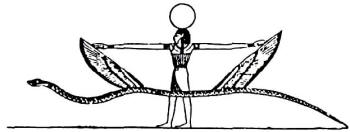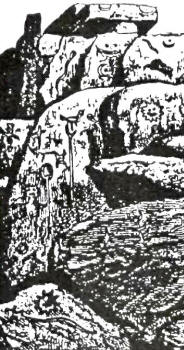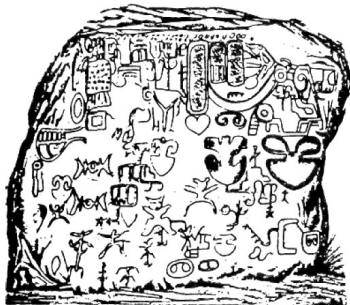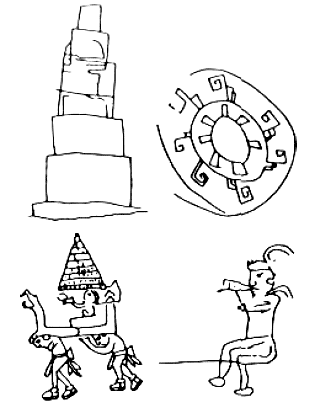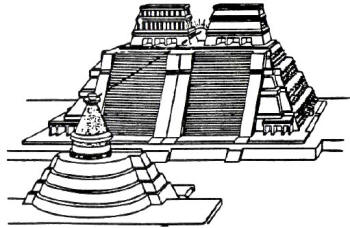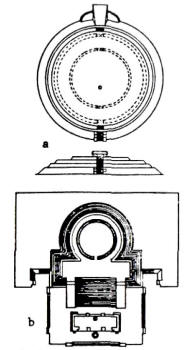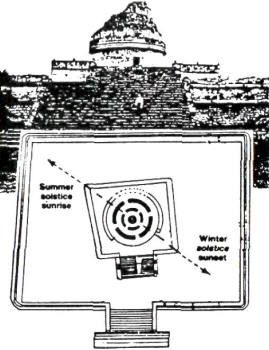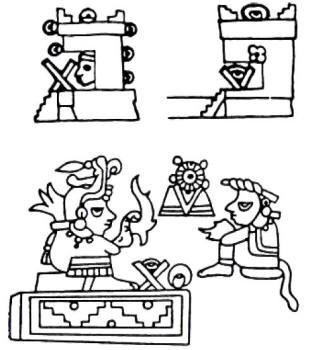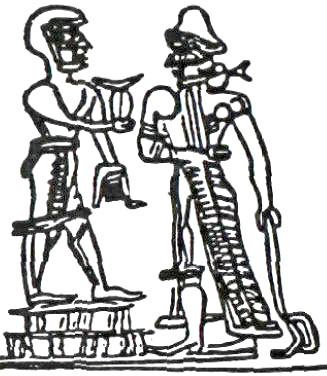|
Historians believe that exile as a deliberate penal policy was introduced by the Assyrians in the eighth century BC. when they "carried off" kings, groups of elders and court officials, or even whole populations from their own lands to live out their lives among strangers in far-off places. In fact, the forced departure of someone into exile was a form of punishment begun by the Gods, and the first exiles were leaders of the Anunnaki themselves.
Such forced deportations, first of Gods and then of people, have changed the course of history. They also left their mark on the calendar, and were linked to the coming of a New Age. When the Spaniards, and then other Europeans, realized how numerous were the similarities in traditions, customs, and beliefs between those of the American natives and those that have been associated with the Bible and the Hebrews, they could think of no other explanation but that the "Indians" were descendants of the Ten Lost Tribes of Israel.
That harkened back to the mystery surrounding the whereabouts of the people belonging to the ten Israelite tribes that formed the Northern Kingdom who were forced into exile by the Assyrian king Shalmaneser. Biblical and postbiblical sources held that, though dispersed, the exiles kept their faith and customs so that they be counted among those who will be redeemed and returned to their homeland. Ever since the Middle Ages, travelers and savants claimed to have found traces of the Ten Lost Tribes as far away as China or as nearby as Ireland and Scotland. In the sixteenth century, the Spaniards were certain that it was such exiles who had brought civilization to the Americas.
While the exile of the ten tribes by the Assyrians in the eighth century BC., and then of the remaining two tribes by the Babylonians two centuries later, are historical facts, the "Ten Tribes Connection" to the New World remains in the realm of intriguing legends. Yet, unknowingly, the Spaniards were right in attributing the beginning of a formal civilization, with its own calendar, in the Americas to an exile; but not of a people - rather, the exile of a God. The peoples of Mesoamerica - the Maya and Aztecs, Toltecs and Olmecs and lesser known tribes - had three calendars.
Two were cyclical, measuring the cycles of the Sun and the Moon and of Venus. The other was chronological, measuring the passage of time from a certain starting point, "Point Zero." Scholars have established that this Long Count calendar's starting point was in the year that is designated under the Western calendar as 3113 BC., but they know not what that starting point signifies. In The Lost Realms we have suggested that it marked the date of the arrival of Thoth, with a small band of aides and followers, in America.
QuetzalcoatI, the Great God of the Mesoamericans, was none other than Thoth, we have suggested. His epithet, the Plumed or Winged Serpent, was well known in Egyptian iconography (Fig. 145). QuetzalcoatI, like Thoth, was the God who knew and taught the secrets of temple building, numbers, astronomy, and the calendar. Indeed, the two other calendars of Mesoamerica by themselves offer clues for the Egyptian Connection and for identifying QuetzalcoatI as Thoth. Fig. 145
The two without doubt reveal the handiwork of "someone" familiar with the much earlier calendars of the Near East. First of the two was the Haab, a solar-year calendar of 365 days that was subdivided into 18 months of 20 days each, plus an additional five special days at year's end. Although the 18 x 20 division is different from the Near Eastern one of 12 x 30, this calendar was basically an adaptation of the Egyptian calendar of 360 days plus 5.
That purely solar calendar, as we have seen, was the one favored by Ra/Marduk; changing its subdivision could have been a deliberate act by Thoth to make it differ from that of his rival. That purely solar calendar did not allow for intercalation - -a device that, in Mesopotamia, was expressed in the addition of a thirteenth month once in a given number of years. In Mesoamerica this number, 13, featured in the next calendar. As in Egypt, which had both a secular (pure solar-year) calendar as well as a sacred one, so was the second Mesoamerican calendar that of the Sacred Year called Tzolkin.
In it the division into 20 also played a role; but it was counted in a cycle that rotated 13 times - the number inserted into the Haab calendar. That 13 x 20 resulted in a total of only 260 days. What this number, 260, represented or how it had originated has engendered many theories but no certain solutions. What is significant, calendrically and historically, is that these two cyclical calendars were meshed together. as gear wheels lock their teeth together (see Fig. 9b), to create the grand Sacred Round of fifty-two solar years; for the combination of 13, 20 and 365 could not repeat itself except once in 18,980 days, which meant fifty-two years.
This grand cycle of fifty-two years was sacred to all the peoples of Mesoamerica, and they related to it events both past and future. It lay at the core of the events associated with the greatest Mesoamerican deity, Quetzalcoatl ("The Plumed Serpent"), who having come to those lands from across the eastern seas was forced by the God of War to go into exile, but vowed to return in the year "1 Reed" of the Exiles on a Shifting Earth 295 fifty-two-year Sacred Cycle.
In the Christian calendar, the parallel years were AD. 1363, 1415, 1467, and 1519; the latter was the very year when Hernando Cortes appeared on the Mexican shores, fair-skinned and bearded as Quetzalcoatl had been; and so it was that the landing was seen by the Aztecs as fulfillment of the prophecy of the Returning God. The centrality of the number fifty-two, if nothing else, as a hallmark of religious and messianic Mesoamerican beliefs and expectations, pointed to a key similarity between Quetzalcoatl and his Sacred Calendar and Thorn's calendar of fifty-two.
The Game of Fifty-two was Thoth's game, and the Tale of Satni earlier related clearly stated that "fifty-two was the magical number of Thoth." We have already explained the significance, in terms of Thoth's feud with Ra/Marduk, of the Egyptian calendar of fifty-two weeks. The Mesoamerican "fifty-two" had "Thoth" stamped all over it. Another hallmark of Thoth was the application of a circular design to edifices related to the calendrical observations of the heavens. The Mesopotamian ziggurats were squarish, with their corners aligned to the cardinal points.
Near Eastern temples - Mesopotamian, Egyptian, Canaan-ite, even Israelite - were rectangular structures whose axis was oriented either to the equinoxes or the solstices (a plan still manifest in churches and temples of our days). Only in the unique edifice that Thoth helped build in Lagash was a circular shape adopted. Its only other Near Eastern emulation was at the temple dedicated to Hathor (i.e. Ninharsag) at Denderah; and at Stonehenge, near where the Old World faces the New World on the other side of the Atlantic Ocean.
In the New World, in the domain of Adad, the younger son of Enlil and chief deity of the Hittites, the usual rectangular shape and orientation of Mesopotamian temples predominated. The greatest and oldest of them with its certain astronomical and calendrical functions, the Kalasasaya at Tiahuanacu, was rectangular and built on an east-west axis, not unlike the temple of Solomon. Indeed, one must wonder whether when the Lord look the prophet Ezekiel flying to show him an actual temple that was to serve as the model for the design of the future temple of Jerusalem, he did not fly him to Tiahuanacu to view the Kalasasaya, as the biblical detailed architectural text and a comparison of Figs. 50 and 124 may well suggest.
Another major southern Andes temple, a focal point of sacred pilgrimages, was the one dedicated to the Great Creator that stood atop a promontory looking out to the expanse of the endless Pacific (not far south from present-day Lima). It too was rectangular in shape. Judging by the design of these structures, Thoth was not invited there to take a hand in their construction. But if, as we believe, he was the Divine Architect of the circular observatories, he was certainly present in the Sacred Valley.
His hallmarks among the structures of the Megalithic Age were the Round Observatory atop the Sacsahuaman promontory, the semicircular Holy of Holies in Cuzco, the Torreon in Machu Picchu. The actual domain of Quetzalcoatl/Thoth was Mesoamerica and Central America, the lands of the Nahuatl-speaking and Mayan tribes; but his influence extended southward into the northern parts of the South American continent.
Petroglyphs found near Cajamarca in the north of Peru (Fig. 146) that depict the Sun, the Moon, five-pointed stars, and other celestial symbols, show repeatedly next to them the symbol of the serpent - the unmistakable emblem of Enki and his clan and specifically so of the deity known as the "Plumed Serpent.'' Figure 146
The petroglyphs also include depictions of astronomical viewing devices, one held by a person (priest?), as was customary in the ancient Near East, and the other with the curved horns, as were the viewing devices erected in Egypt at the temples of Min (see Fig. 61).
The site appears to have been where ancient routes in the gold lands of the Andes, from the Pacific coast and from the Atlantic coast, met as the latter followed the rivers. Cajamarca itself, somewhat inland, and the natural harbor for it at Trujillo on the Pacific coast, in fact played a historic role in the European conquest of Peru. It was there, at Trujillo, that Francisco Pizarro and his small band of soldiers landed in 1530. They marched inland and established their base at Cajamarca, a city "whose plaza was larger than any in Spain" and "whose buildings were three times the height of a man," according to the reports of the Conquistadors.
It was to Cajamarca
that the last Inca emperor, Atahualpa, was lured, only to be
imprisoned for a ransom of gold and silver. The ransom was the
filling up of a room twenty-five feet long and fifteen feet wide, as
high as a man could not reach, with these precious metals. The
ministers and priests of the king's retinue ordered that objects and
artifacts made of gold and silver be brought from all over the land;
S.K. Lothrop (Inca Treasure as Depicted by Spanish Historians)
figured out that what the Spaniards then sent back to Spain from
that ransom amounted to 180,000 ounces of gold and twice as much in
silver. (Having collected the ransom, the Spaniards executed
Atahualpa all the same.) Figure 147
Moving on northward, the Egyptian symbol par excellence, the drawing of a pyramid, is found among "graffiti" in the tomb area of Holmul, Guatemala (Fig. 148), thereby identifying the early inhabitants of Central America as familiar with Egypt. Also depicted is a circular stage-tower and next to it, apparently, its ground plan. It has all the appearance of a round observatory, similar to the one that had existed on the Sacsahuaman promontory down south.
Figure 148
Incredible as it may sound, reference to petroglyphs with astronomical symbols is made in ancient Near Eastern writings. The Book of Jubilees, enlarging and fleshing out the concise biblical record of the generations that followed the Deluge, describes how Noah instructed his descendants by relating to them the tale of Enoch and the knowledge that was granted him.
The narrative continues thus: In the twenty-ninth jubilee, in the first week, in the beginning thereof, Arpachshad took to himself a wife and her name was Rasu'eja, the daughter of Shushan, the daughter of Elam, and she bare him a son in the third year in this week, and he called his name Kainam. And the son grew, and his father taught him writing, and he went to seek for himself a place which he might occupy as a city for himself.
And he found a writing which former generations had carved on the rock, and he read what there was thereon, and he transcribed it and sinned as a result thereof; for it contained the teaching of the Guardians in accordance with which they used to observe the omens of the sun and moon and stars in all the signs of heaven.
The petroglyphs, we learn from this millennia-old text, were not mere graffiti; they were expressions of knowledge of the "teachings of the Guardians" - the Anunnaki - "in accordance with which they used to observe the omens of the Sun and the Moon and the stars"; the petroglyphs were the "signs of heaven" of "former generations."
The depictions on rocks that we have just shown, including, as they do, round observatories, must be taken as eyewitness reports of what had actually been known and seen in antiquity in the Americas. Indeed, in the heartland of Quetzalcoatl's domain, in Mexico, where the petroglyphs evolved into hieroglyphs akin to the earliest ones in Egypt, the most obvious traces of his presence are astronomically aligned temples, including circular and semicircular ones, and round observatories.
Such remains begin with two perfectly round mounds that marked out the astronomical sightline at La Venta, one of the earliest sites of the Olmecs - African followers of Thoth who had arrived in Mexico by crossing the Atlantic circa 2500 BC. At the other extreme of the four millennia that passed from then till the Spanish conquest, the latest instance of observatory-in-the-round was the semicircular pyramid in the sacred precinct of the Aztecs in Tenochtitlan (later Mexico City). It was so positioned that it served to determine the Day of the Equinox by watching, from the round "Tower of Quetzalcoatl," the Sun rise precisely between the opposite Pyramid of the Two Temples (Fig. 149). Figure 149
Chronologically, between the early Olmecs and the late Aztecs, were the countless pyramids and sacred observatories of the Mayas. Some of them, as the one at Cuicuilco (Fig. 150a), were perfectly round. Others, like the one at Cempoala (Fig. 150b) began, as archaeologists have established, as purely round structures but in time changed shape as the small original stairways leading to their top stages evolved into monumental stairways and plazas. Figures 150a and I50b
The most renowned of these structures is the Caracol in Chichen Itza in the Yucatan peninsula - a circular observatory (Fig. 151) whose astronomical functions and orientations have been studied extensively and firmly established. Although the presently seen structure is believed to have been built only in AD. 800 or thereabouts, it is known that the Mayas took over Chichen Itza from earlier settlers, erecting Mayan structures where older ones used to be. An original observatory, scholars surmise, must have stood at the site at much earlier times, built-over and rebuilt as was the Mayan custom regarding the pyramids. Figure 151
The sightlines in the existing structure have been extensively researched, and undoubtedly include the principal points of the Sun - the equinoxes and solstices, as well as some of the Moon's major points. Alignments with various stars are also suggested, though not with Venus; that is odd, for in Maya codices the movements of Venus are the principal subject. It is one of the reasons for believing that the sightlines were not devised by Mayan astronomers, but were inherited by them from previous eras.
The Caracol's ground plan - a round tower within a squarish enclosure as
part of a larger rectangular structural frame, and the openings for
sightlines in the tower itself - bring to mind the shape and layout
(now seen only by their foundations) of the circular observatory
within its square enclosure and larger rectangular complex at
Sacsahuaman above Cuzco (see Fig. 120). Is there much doubt that
both were designed by the same Divine Architect? In our opinion, he
was Thoth. Figure 152
One, in Codex Bodley (bottom of Fig. 152), indicates that the two astronomer-priests are viewing the Sun as it rises between two mountains; that is exactly how the Egyptian hi eroglyphic texts depicted the idea and the word "horizon"; and it may not be by chance alone that the two mountains in the Mayan codex look like the two great pyramids of Giza. The links with the ancient Near East in general, and with Egypt in particular, that are evidenced by glyphs and archaeological remains are augmented by legends.
The Popol Vuh, the "Council Book" of the highland Mayas, contains an account of how the sky and the Earth were formed, how the Earth was divided into four regions and partitioned, and how the measuring cord was brought and stretched in the sky and over the Earth, creating the four corners. These are all elements basic to Near Eastern cosmogony and sciences, recollections of how the Earth was divided among the Anunnaki, and the functions of the Divine Measurers.
Both Nahuatlan traditions, as well as Mayan ones in such forms as the Legend of Votan, recount the arrival of "the Fathers and the Mothers," the tribal ancestors, from across the seas. The Annals of Cakchiquels, a Nahuatlan record, states that while they themselves came from the west, there were others who had come from the east, in both instances "from the other side of the sea."
The Legend of Votan, who had built the first city that was the cradle of Mesoamerican civilization, was written down by Spanish chroniclers from oral Mayan traditions. The emblem of Votan, they recorded, was the serpent; "he was a descendant of the Guardians, of the race of Can." "Guardians" was the meaning of the Egyptian term Neteru (i.e. "Gods"). Can, studies such as that by Zelia Nuttal (Papers of the Peabody Museum) have suggested, was a variant of Canaan who was (according to the Bible) a member of the Hamitic peoples of Africa and a brother-nation of the Egyptians.
The possibility, which we have already mentioned, that the earliest migrants might have been descendants of Cain, relates Nahuatlan beginnings to one of the first recorded forced deportations: the exiling of Cain as punishment for the killing of Abel. The very first one, according to the Bible, was the expulsion of Adam and Eve from the Garden of Eden. In our times the exiling of kings has been a known occurrence; the exiling of Napoleon to the island of St. Helena is a notorious example.
The biblical record shows that this mode of punishment goes back to the very beginnings of time, when Mankind was held to a certain code of ethics by the "Gods." According to the earlier and more detailed Sumerian writings, it was in fact the Gods themselves who applied the punishment to their own sinners; and the very first recorded instance concerned their commander in chief, Enlil: he was exiled to a land of banishment for the crime of raping a young Anunnaki nurse (in the end he married her and was given a reprieve).
It is clear from Nahuatlan and Mayan legends that Quetzalcoatl (Kukulkan in Mayan lore) had come to their lands with a small band of followers, and that his eventual departure was a forced one - an exile imposed by the War God. We believe that his arrival was also the result of a forced departure, an exile, from his native land, Egypt. The date of that first event is a vital component of the Mesoamerican counts of Time.
We have already discussed the centrality of the Sacred Round of fifty-two years in Mesoameriean calendrical, religious, and historical affairs, and shown that it was the sacred number of Thoth. Next in significance was a Grand Cycle of "perfect years" that encompassed thirteen eras of baktuns, units of four hundred years that were a key element in the consecutive calendar known as the Long Count.
The smallest unit in the Long Count calendar was the kin, a single day, and it was built up to larger numbers that could run into the millions of days by a series of multiplications, by 20 and by 360: 1 kin = 1 day 1 uinal = 1 kin x 20 = 20 days 1 tun =1 kin x 360 = 360 days 1 ka-tun = 1 tun x 20 = 7,200 days 1 bak-tun = I ka-tun x 20 = 144,000 days
As a purely arithmetical exercise the multiplications by twenty could continue, increasing the number of days that each term and its specific glyph represented, going on to 2,880,000 and 57,600,000 and so on. But in practice the Maya did not go beyond the baktun; for the count that began from the enigmatic starting point in 3113 BC. was deemed to run in cycles of thirteen baktuns.
Modern scholars divide the number of days that the Long Count indicates on Mayan monuments not by the perfect 360 but rather by the actual number 365.25 days of the solar year; thus, a monument stating "1,243,615" days is read to mean the passage of 3,404.8 years from August 3113 BC., i.e. a.d. 292. The concept of Ages in Earth's history and prehistory was a basic tenet of the pre-Columbian civilizations of Mesoamerica.
According to the Aztecs, their Age or "Sun" was the fifth one and "began 5,042 years ago." While the Nahuatlan sources were not specific about how much longer this age was to last, the Mayan sources provided a more precise answer through the Long Count. The present "Sun," they said, will last precisely thirteen baktuns - 1,872,000 days from Point Zero. This represents a Grand Cycle of 5,200 "perfect years" of 360 days each. In The Mayan Factor Jose Arguelles concluded that each baktun date had acted as a milestone in the history and prehistory of Mesoamerica, as will the year a.d. 2012, in which the thirteen baktuns that began in 3113 BC. will be completed.
He deemed the number 5,200 a key to understanding Mayan cosmogony and ages past and future. In the 1930s Fritz Buck (El Calendario Maya en la Cultura de Tiahuanacu), seeing comparable elements between the Mayan calendars and that of Tiahuanacu, considered the starting date and other periodical markers to be related to actual events affecting the American peoples.
He believed that a key symbol on the Gate of the Sun represented 52 and another one 520, and accepted as historically significant the number of 5,200 years; he held, however, that not one but two Great Cycles have to be considered, and that since 1,040 years remain in the second Great Cycle, the first one began in 9360 BC. It was then, he held, that the legendary events and the tales of the Gods in the Andes began. The second Great Cycle, accordingly, began at Tiahuanacu in 4160 BC. In arriving at a.d. 2012 as the end of the Fifth Sun, Jose Arguelles followed the present custom of dividing the 1,872,000 days by the actual number of 365.25 days in a solar year, resulting in the passage of only 5,125 years since the starting point in 3113 BC.
Fritz Buck on the other hand saw no need for such an adjustment, believing that the division should follow the Mayan 360 "perfect year." AcExiles on a Shifting Earth 307 cording to Buck, the historic age through which the Aztecs and Mayas had lived was to last a perfect 5,200 years. This number, like fifty-two, is connected with Thoth ac-cording to ancient Egyptian sources. Among them were the writings of an Egyptian priest whom the Greeks called Manetho (his hieroglyphic name meant "Gift of Thoth").
He recorded the division of monarchies into dynasties, including the divine and semidivine ones that preceded the pharaonic dynasties; he also provided lengths of reign for all of them. Corroborating legends and tales of the Gods from other sources, the list by Manetho asserts that the seven great Gods - Ptah, Ra, Shu, Geb, Osiris, Seth, and Horus - reigned a total of 12,300 years. Then began a second divine dynasty, headed by Thoth; it lasted 1,570 years.
It was followed by thirty demigods who reigned 3,650 years. A chaotic time followed, a period of 350 years during which Egypt was disunited and in disarray. After that a person called Men established the first pharaonic dynasty. Scholars hold that this happened circa 3100 BC. We have held that the actual date was 3113 BC., the starting point of the Mesoamerican Long Count, it was then, we believe, that Marduk/Ra, reclaiming lordship over Egypt, expelled Thoth and his followers from that land, forcing them into exile in another, distant, land. And if the preceding reign of Thoth himself (1,570 years) and of his appointed demigods (3,650 years) is tallied, the result is 5,220 years - a mere discrepancy of 20 years from the 5,200 perfect years that make up the Great Mayan Cycle of thirteen baktuns.
As with 52, so was 5,200 a "number of Thoth." In the olden days, when the Anunnaki were the Lords, the banishment and exile of Gods marked milestones in what we have named The Earth Chronicles. Much of that part of the tale concerns Marduk, alias Ra in Egypt; and the calendar - the count of Divine, Celestial, and Earthly Time - played a major role in those events.
The reign of Thoth and his dynasty of demigods, ending circa 3450 BC., was followed in Egypt, according to Manetho, by a chaotic period that lasted 350 years, in the aftermath of which dynastic rule by pharaohs beholden to Ra began. Segments of the 175th chapter of the Book of the Dead (known as the Papyrus of Ani) record an angry ex-change between a reappearing Ra and Thoth. "O Thoth, what is it that has happened?" Ra demanded to know.
The Gods, he said, "have made an uproar, they have taken to quarreling, they have done evil deeds, they have created rebellion." They must have belittled Ra/Marduk in the course of their rebellion: "They have made the great into small." Ra, the Great God, pointed an accusing finger at Thoth; the accusation directly concerned changes in the calendar: Thoth, Ra accused, "their years cut short, their months had curbed."
This Thoth had achieved by "the destruction of Hidden Things that were made for them." While the nature of the Hidden Things whose destruction shortened the year and the months remains unknown, the outcome could have only meant a switch from the longer solar year to the shorter lunar year - the "making of the great into small." The text ends with Thoth's accepting a sentence of exile and banishment: "I am departing to the desert, the silent land." It is such a tough place, the text explains, that "sexual pleasures are not enjoyed in it"...
Another little-understood hieroglyphic text, found in one of Tutankhamen's shrines as well as in royal tombs in Thebes, may have recorded the expulsion order by Ra/Marduk and gave among the reasons the calendrical conflict between the "Sun God" and the "Moon God" (Thoth). The text, which scholars are certain originated at a much earlier time, relates how Ra ordered that Thoth be summoned to him. When Thoth came before Ra, Ra announced:
Some scholars title the text "The assignment of functions to Thoth." In fact, it was the "assignment" of Thoth to an unidentified distant land because of his "functions" - calendrical preferences - relating to the Moon. The exiling of Thoth was treated in Mesoamerican timekeeping as Point Zero of the Long Count - -according to accepted chronology, in the year 3113 BC.
It must have been an event whose repercussions were recalled far and wide, for it could not be a mere coincidence that according to Hindu traditions (that also divide Earth's history and prehistory into Ages) the present Age, the Kaliyuga, began on a day equivalent to midnight between February 17 and 18 in 3102 BC. This date is uncannily close to the date of Point Zero of the Mesoamerican Long Count, and is, therefore, in some way connected to the exiling of Thoth.
But no sooner than Marduk/Ra forced Thoth to leave the African domains, did he himself become the victim of a similar fate: exile. With Thoth gone and his brothers Nergal and Gibil remote from the center of Egyptian power, Ra/Marduk could have expected an undisturbed supremacy there. But a new rival had emerged on the scene. He was Dumuzi, the youngest son of Enki, and his domain was the grasslands south of Upper Egypt.
Unexpectedly, he emerged as a pretender to the Lordship over Egypt; and as Marduk soon discovered, the ambitions were prompted by a love affair of which Marduk was most disapproving. Preceding by millennia the setting and principals in Shakespeare's Romeo and Juliet, Dumuzi's bride was none other than Inanna/Ishtar, a granddaughter of Enlil and one who had fought alongside her brother and uncles to defeat the Enki'ites in the Pyramid Wars.
With limitless ambition, Inanna
saw in the espousement with Dumuzi a great role for herself - if only
he were to cease being just the Herder (as his epithet was) and
assume lordship over the great Egyptian nation: "I had a vision of a
great nation choosing Dumuzi as God of its country," she later
confided, "for I have made Dumuzi's name exalted, I gave him
status."
Marduk, fearing her wrath, hid inside the Great Pyramid, all the while asserting his innocence because the death of Dumuzi was unintended, accidental. Unrelenting, Inanna "ceased not striking" at the pyramid, "at its corners, even its multitude of stones." Marduk issued a warning that he would resort to the use of awesome weapons "whose outburst is terrible." Fearing another terrible war, the Anunnaki convened the supreme court of the Seven Who Judge.
It was decided that Marduk must be punished, but since he did not directly kill Dumuzi, he could not be sentenced to death. The verdict was therefore to bury Marduk alive in the Great Pyramid within which he took refuge, by hermetically sealing it with him inside. Various texts, quoted by us at length in The Wars of Gods and Men, relate the ensuing events, the commutation of Marduk's sentence, and the dramatic effort to cut through the massive pyramid, using its original architectural drawings, to reach Marduk in time. The step-by-step rescue is described in detail.
So
is the conclusion of the incident: Marduk was sentenced to exile,
and in Egypt Ra became Amen - the Hidden One, a God no longer seen. As
for Inanna, robbed by Dumuzi's death of her dream of being the Lady
of Egypt, she was given Erech to be her "cult center" and the domain
of Aratta to become the third region of civilization - that of the
Indus Valley - circa 2900
We really do not know, but he must have been somewhere not too far away, for he was watching developments in the Near East and continuing his scheming to seize the supremacy on Earth - supremacy, he believed, wrongly denied to his father Enki. In Mesopotamia Inanna, ruthless and cunning, maneuvered the kingship of Sumer into the hands of a gardener whom she had found to be a man to her liking. She named him Sharru-kin, "righteous ruler," known to us as Sargon I.
With Inanna's help he expanded his domains and created a new capital for a greater Sumer hence to be known as Sumer and Akkad. But seeking legitimacy, he went to Babylon - Marduk's city - and there removed some of its hal-lowed soil to use for foundations in his new capital. That was the opportunity for Marduk to reassert himself. "On account of the sacrilege thus committed," Babylonian texts recorded, "the great lord Marduk became enraged" and destroyed Sargon and his people; and, of course, reinstated himself in Babylon.
There he began to fortify the city and enhance its underground water system, making it impervious to attack. As the ancient texts reveal, it all had to do with Celestial Time. Alarmed by the prospect of yet another devastating War of the Gods, the Anunnaki met in council. The chief antagonist was Ninurta, the heir apparent of Enlil, whose birthright Marduk was directly challenging. They invited Nergal, a powerful brother of Marduk, to join them in seeking a peaceful solution to the looming conflict.
Mixing compliments with persuasion, Nergal first calmed down Ninurta, then agreed to go to Babylon similarly to persuade Marduk to step back from an armed confrontation. The chain of events, with dramatic and in the end fateful turns and consequences, is described in detail in a text known as the Erra Epos (Erra having been an epithet of Nergal). It includes many of the verbal exchanges between the participants as though a stenographer were present; and indeed, the text (as its postscript attests) was dictated to a scribe after the events by one of the participating Anunnaki.
As the story unfolds, it becomes increasingly clear that what was happening on Earth had been related to the heavens - to the constellations of the zodiac. In retrospect, the statements and positions taken by the contestants for the supremacy on Earth - Marduk the son of Enki and Ninurta the son of Enlil - lead to no other conclusion than that the issue was the coming of a New Age: the impending change from the zodiac house of the bull (Taurus) to the zodiac house of the ram (Aries) as the one in which the spring equinox, and thus the calendrical moment for the New Year, would occur.
Listing all his attributes and heirlooms, Ninurta thus asserted:
The statement asserts verbally what the depictions, such as we have shown in Fig. 93, have illustrated pictorially: the zodiacal time when the spring equinox began in the House of the Bull (Taurus) and the summer solstice occurred in the zodiac of the Lion (Leo) belonged to the Enlilites, whose "cult animals" were the Bull and the Lion. Carefully, choosing his words, Nergal formulated his answer to the assertive Ninurta. Yes, he said, all that is true. But
Its emergence, Nergal continued, is unavoidable:
In its relentless precessional retardation, while the zo-diacal constellation of the Bull was still dominant, "on the rim of the Sun's orbit" one could already see the approaching Age of the Ram. But while the change was unavoidable, the time for it had not yet come. "The other Gods are afraid of battle," Nergal said in conclusion.
It could all be explained to Marduk, he felt. "Let me go and summon the prince Marduk away from his dwelling," make him leave peacefully, Nergal suggested. And so, with Ninurta's reluctant consent, Nergal set out on a fateful mission to Babylon. On the way he stopped at Erech, seeking an oracle from Anu at his temple, the E.ANNA. The message he carried to Marduk from "the king of the Gods" was this: the Time has not yet come.
The Time in question, the conversation-debate between Nergal and Marduk makes clear, was the impending zodiacal change - the coming of a New Age. Marduk received his brother in the E.SAG.IL, the ziggurat-temple of Babylon; the meeting took place in a sacred chamber called SHU.AN.NA, "The Celestially Supreme Place," which evidently Marduk deemed the most suitable place for the discussion; for he was certain that his time had come, and even showed Nergal the instruments he used to prove it.
(A Babylonian artist, depicting the encounter between the two brothers, showed Nergal with his identifying weapon, and a helmeted Marduk standing atop his ziggurat and holding in his hand a device - Fig. 153 - that looks very much like the viewing instruments that were employed in Egypt at the temples of Min.)
Figure 153
Realizing what had happened, Nergal argued to the con-trary. Your "precious instrument," he told Marduk, was imprecise, and that is what had caused him to interpret incorrectly "the glow of the heavenly stars as the light of the ordained day." While in your sacred precinct you have concluded that "on the crown of your lordship the light did shine," it was not so at the Eanna, where Nergal had stopped on his way.
There, Nergal said, "the face of E.HAL. AN.KI in the Eanna remains covered over.'' The term E.HAL.AN.KI literally means "House of the circling of Heaven-Earth" and, in our view, suggests the location of instruments for determining the Earth's precessional shift. But Marduk saw the issue differently. Whose instruments were really incorrect? At the time of the Deluge, he said, the "regulations of Heaven-Earth shifted out of their groove and the stations of the celestial Gods, the stars of heaven, have changed and did not return to their [former] places."
A major cause of the change, Marduk claimed, was the fact that "the Erkallum quaked and its covering was diminished, and the measures could no longer be taken." This is a highly significant statement, whose scientific importance - as that of the full text of the Erra Epos - has been ignored by scholars. Erkallum used to be translated "Lower World" and more recently the term is left intact, untranslated, as a word whose precise meaning is undetermined. We suggest that it is a term that denotes the land at the bottom of the world - Antarctica; and that the "covering" or more literally "hair-growth-over" is a reference to the ice cap that, Marduk claimed, was still diminished millennia after the Deluge.
When it was all over, Marduk continued, he sent emissaries to check the Lower World. He himself went to take a look. But the '"covering," he said, "had become hundreds of miles of water upon the wide seas": the ice cap was still melted. This is a statement that corroborates our assertion, in The 12th Planet, that the Deluge was an immense tidal wave caused by the slippage of the Antarctic ice covering into the adjoining ocean, some 13,000 years ago.
The event was the cause, we held, of the abrupt end of the last ice age and the climatic change it had brought about. It also left the Antarctic continent bare of its ice covering, enabling the seeing - and, evidently, mapping - of that continent as its landmass and shorelines really are.
The implication of Marduk s statement that the "regulations of Heaven-Earth had shifted out of their groove" as a result of the melting of the immense ice cap and the redistribution of its weight as water all over the world's seas, bears further study. Did it imply a change in Earth's declination? A somewhat different retardation and thus a different precessional schedule? Perhaps a slowing down of the Earth's spin, or of its orbit around the Sun?
The results of experiments simulating the Earth's motions and wobbles with and without an Antarctic ice mass could be most illuminating. All that, Marduk said, was aggravated by the fate of instruments in the Abzu, the southeastern tip of Africa. We know from other texts that the Anunnaki had a scientific station there that monitored the situation before the Deluge and was thus able to alert them to the impending calamity. "After the regimen Heaven-Earth was undone," Marduk continued, he waited until the fountains dried up and the floodwaters receded.
Then he "went back and looked and looked; it was very grievous." What he had discovered was that certain instruments "that to Anu's heaven could reach" were missing, gone. The terms used to describe them arc believed by scholars to refer to unidentified crystals. "Where is the instrument for giving orders?" he asked angrily, and "the oracle stone of the Gods that gives the sign for lordship... Where is the holy radiating stone?"
These pointed questions regarding the missing precision instruments, which used to be operated by the "divine chief craftsman of Anu-powers who carried the holy All-Knower of-the-Day," sound more like accusations than inquiries. We have earlier referred to an Egyptian text in which Ra/ Marduk accused Thoth of destroying "the Hidden Things" that were used for determining the Earth's motions and calendar; the rhetorical questions thrown at Nergal imply deliberate wrongdoing against Marduk. In such circumstances, Marduk indicated, was he not right to rely on his own instruments to determine when his Time - the Age of the Ram - had arrived?
Nergal's full response is unclear because where it begins several lines on the tablet have been damaged. It appears that based on his own vast African domains, he did know where some of the instruments (or their replacements) were. He thus suggested that Marduk go to the indicated sites in the Abzu and verify it all for himself. He was certain that thereupon Marduk would realize that his birthright was not at risk; what was being challenged was the timing of his ascendancy.
To put Marduk further at ease. Nergal promised that he would personally see to it that nothing would be disturbed in Babylon during Marduk's absence. And, as a final gesture of reassurance, he promised to make the celestial symbols of the Enlilite Age, "the bulls of Anu and Enlil, crouch at the gate of thy temple."
Such a symbolic act of obeisance, the bowing to Marduk of Enlil's Bull of Heaven at the entrance to Marduk's temple, persuaded Marduk to accept his brother's plea:
Thus did the dispute regarding the correct timing of the zodiacal change lead to Marduk's second exile - temporary only, he believed. But as fate would have it, the anticipated coming of a New Age was not to be a peaceful one.
|
